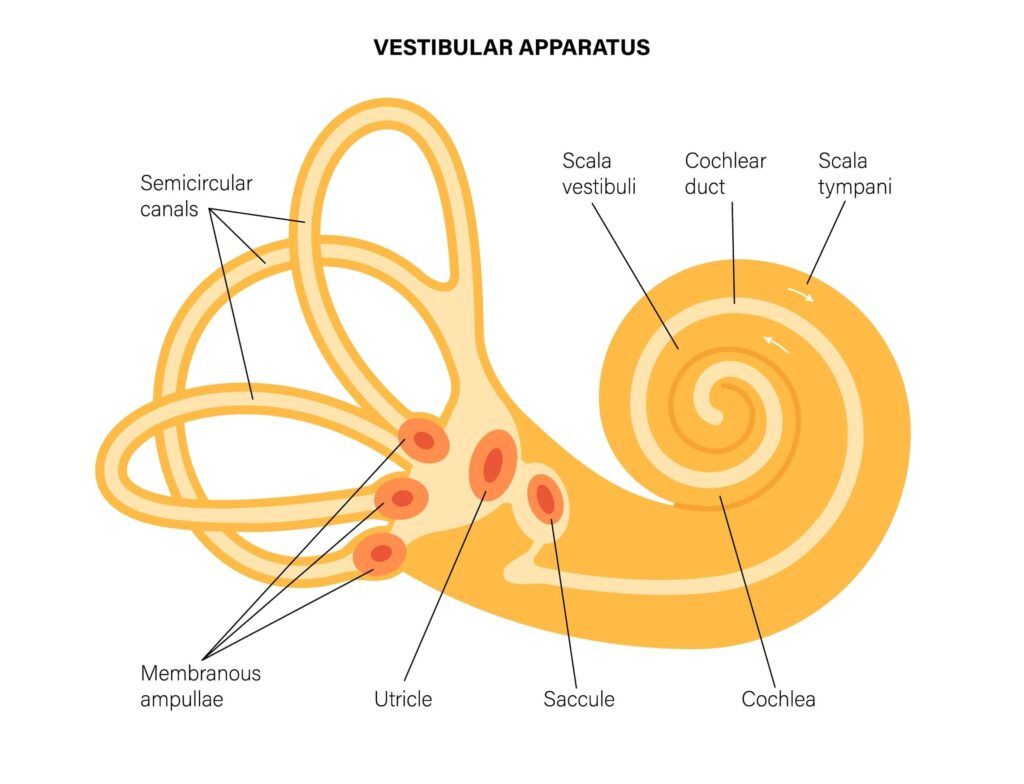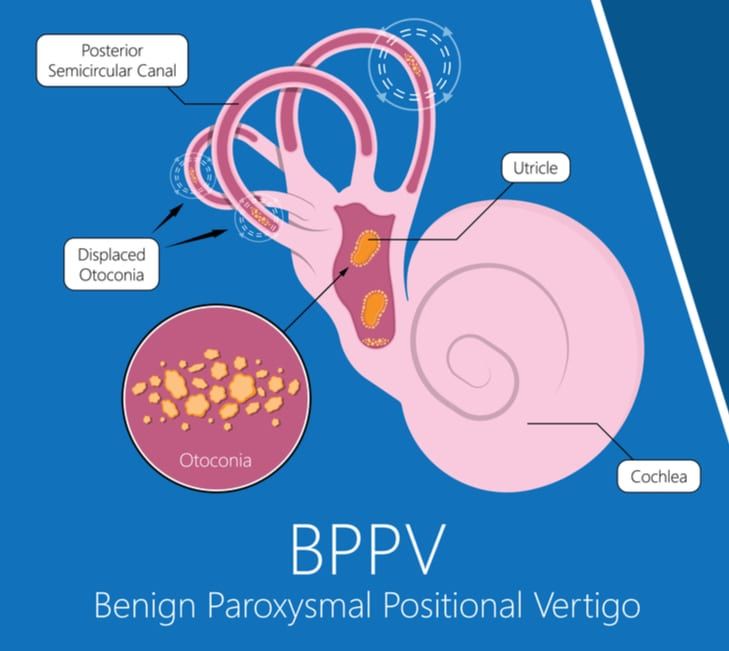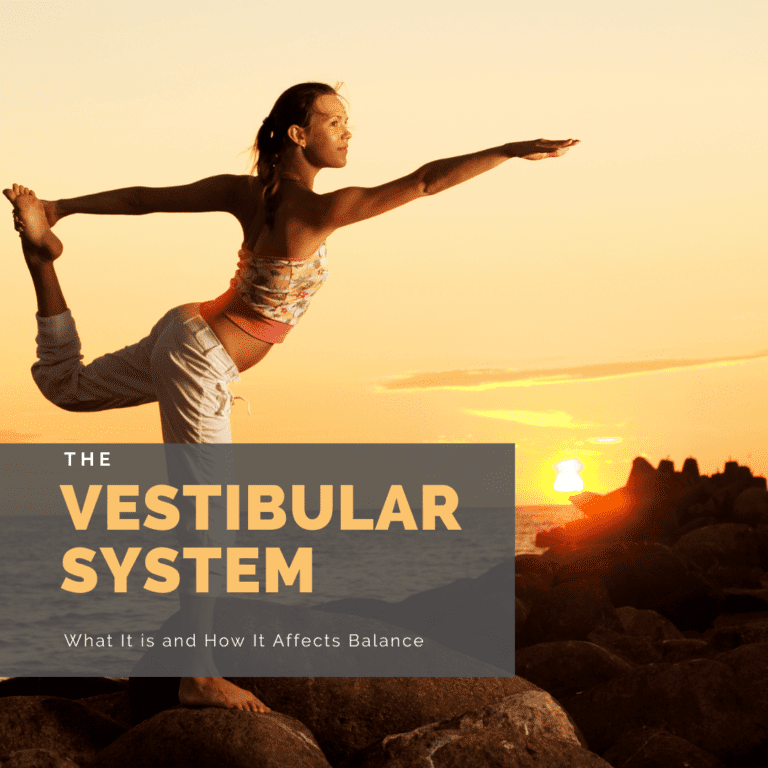Have you ever watched in awe as Olympic gymnasts complete a seemingly impossible routine on a balance beam? Maybe you’ve even tested your balance by walking on a narrow surface. Even if you haven’t consciously tested your balance, your body is constantly carrying out several processes to ensure that you remain upright. In fact, the reason why you can easily walk on a variety of surfaces without stumbling constantly is thanks to your vestibular system. This blog post will explore what this system does, why it’s important for balance, and what can go wrong if it becomes impaired.
What Is the Vestibular System?

The vestibular system is a complex sensory system that regulates our balance and spatial orientation. It is located within the inner ear in a region known as the vestibular labyrinth. The vestibular system consists of:
- semicircular canals: there are three tubes that are almost at 90 degree angles to one another. Each one can detect a different type of movement: nodding up and down, shaking side to side, or tilting left and right. This is possible because the semicircular canals are filled with fluid that moves through the canal in coordination with the type of movement being detected.
- two otolith organs: there are two otolith organs that can detect linear acceleration, gravitational forces, and tilting movements. These otolith organs are made up of calcium carbonate crystals within the utricle and saccule. The utricle detects movement in the horizontal plane, while the saccule detects movement in the vertical plane.
The vestibular nerve transmits information from these vestibular organs to brainstem nuclei which then relay it to other parts of the central nervous system where it is used by the cerebellum and cerebral cortex for movement coordination. There are vestibular organs on both sides of the head that must send symmetrical signals to the brain in order to function properly.
How the Vestibular System Affects Balance

Balance is defined as the ability to maintain equilibrium, an upright posture, and stability on your feet. In order to be balanced, there are a variety of sensory and motor processes that must work together with the vestibular system simultaneously. These include sensory input from vision and touch, as well as motor output to muscles in the body and eyes.
Sensory input from vision provides information on an individual’s orientation in relation to the world around them, while sensory input from touch provides information on how our body is physically interacting with the space. Input from touch can also indicate directionality and the type of surface we are on.
The vestibular system senses the orientation of our body relative to gravity and thus helps us maintain balance. It can also provide sensory information about motion and equilibrium. The cerebellum region of our brain can use this information with visual input from our eyes (to see where we’re going), as well as touch inputs from muscles and joints (which tells us about the position of parts of our body) to keep our bodies balanced. In the case that the cerebellum detects a lack of balance, it will send messages to the necessary muscle groups in order to regain balance.
What can go wrong with the vestibular system?
Proper functioning of this intricate sensorimotor pathway plays an important role in our everyday lives. When one or more of these components are compromised, our sense of balance can also become impaired. Components of the sensorimotor pathway can become compromised by injury, aging, drugs, or disease. When this happens, it is known as a vestibular balance disorder. Balance disorders can cause symptoms such as:
- a loss of balance
- nausea
- vertigo
- sensation of floating
- dizziness
- disorientation
- blurred vision
- falling or stumbling
There are two common types of balance disorders, including benign paroxysmal positional vertigo (BPPV) and Meniere’s Disease.
Benign Paroxysmal Positional Vertigo (BPPV)

BPPV is the most common cause of vertigo and is often triggered by a quick change in position, such as rolling over in bed. People with BPPV experience brief periods of dizziness, loss of balance, nausea or vomiting.
BPPV is caused by loose calcium carbonate crystals that have dislodged from their normal location within one part of our vestibular labyrinth (the utricle and saccule) and have become deposited in another area (the semicircular canals). As a result, the semicircular canals become extremely sensitive to head positions, which causes extreme dizziness. This is a positional disorder, meaning that the problem lies with gravity and head position relative to it.
Meniere’s Disease
Meniere’s Disease is another possible cause of vertigo. However, vertigo usually occurs after other symptoms such as changes in ear pressure, fullness in the ear, decreased hearing, and low-tone ear ringing. In most cases, Meniere’s disease starts with a single symptom and gets progressively worse. In some cases, symptoms are episodic in nature with symptom-free periods in between episodes.
Meniere’s Disease is caused by fluid buildup in the vestibular labyrinth. Normally, fluid in the inner ear known as endolymph resides in the semicircular canals. With Meniere’s disease there is excess endolymph in the semicircular canals which can also flow into other parts of the vestibular labyrinth. The result is a loss of the ability to sense motion and equilibrium, causing extreme dizziness and nausea.
How are vestibular balance disorders treated?
Vestibular balance disorders are treated based on their specific cause. Some treatments may include medications, lifestyle changes, Epley maneuver, and surgery.
- Medications for vestibular balance disorders may include antibiotics or antifungal treatments to treat ear infections. Certain medications are also directed toward vertigo relief. Typically, vestibular suppressants and anti-nausea medications are prescribed as needed. Some of these medications include meclizine (Antivert), prochlorperazine (Compazine), diazepam (Valium), lorazepam (Ativan) and alprazolam (Xanax).
- Lifestyle changes that may help with some balance disorders include decreased salt intake (to decrease water retention), quitting smoking, decreasing alcohol consumption, limiting caffeine & alcohol, and avoiding medications that may cause dizziness.
- An Epley Maneuver is a type of physical therapy that can be used to treat BPPV. The maneuver repositions calcium carbonate crystals in an attempt to restore proper balance function and relieve symptoms such as dizziness, nausea or vomiting.
- Surgery may also be considered for severe cases of vestibular disorders. The type of surgical technique can vary depending on a number of factors. It is also important to note that many balance disorders can be treated without the need for surgery.
Conclusion:
In this blog post we have discussed the vestibular system and how it affects balance. The vestibular system is part of our sensorimotor pathway, which makes it an important part of our central nervous system. This blog post has also covered the two most common types of balance disorders, BPPV and Meniere’s disease, as well as their causes and treatments.

Dr. Kashouty, a diplomate of the American Board of Psychiatry and Neurology (ABPN), practices general neurology with fellowship trained specialization in clinical neurophysiology. Dr. Kashouty finds the form and function of the nerves and muscles the most interesting part of neurology, which is what led him to specialize in neurophysiology with more emphasis on neuromuscular conditions. He treats all neurological diseases, but his main focus is to treat and manage headaches, movement disorders and neuromuscular diseases.




